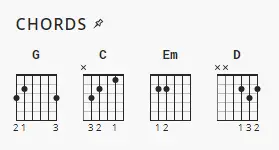Beginner Guitar Chords: G, C, D & Em | Parkland Guitar Lessons

2025-04-17
When you're just starting out on guitar, the number of chords can feel overwhelming. But here's the good news: you can play hundreds of songs using just a few basic open chords. In this guide, we'll walk you through four of the most important ones — G major, C major, D major, and E minor — and show you how they work together to form the foundation of popular music.
What Are Open Chords?
Open chords (also called “cowboy chords”) are chords that use a combination of fretted and open strings. They’re the first chords most guitarists learn because they’re relatively easy to finger and sound great on acoustic or electric guitar.
Let’s break down each chord one by one:
G Major
The G major chord is one of the most versatile and commonly used chords. It uses all six strings and sounds full and bright.
- Index finger on 2nd fret of A string (5th string)
- Middle finger on 3rd fret of low E string (6th string)
- Ring finger on 3rd fret of high E string (1st string)
C Major
Another essential chord, C major has a warmer, softer tone and is used in countless ballads and acoustic songs.
- Index finger on 1st fret of B string (2nd string)
- Middle finger on 2nd fret of D string (4th string)
- Ring finger on 3rd fret of A string (5th string)
- Do not play the low E string
D Major
D major is the perfect chord for bright, open-sounding transitions. You'll use it a lot when moving between G and C.
- Index finger on 2nd fret of G string (3rd string)
- Middle finger on 2nd fret of high E string (1st string)
- Ring finger on 3rd fret of B string (2nd string)
- Only strum the bottom four strings
E Minor (Em)
E minor is the easiest chord for most beginners — and one of the most emotional-sounding. It uses just two fingers and has a haunting, open quality.
- Middle finger on 2nd fret of A string (5th string)
- Ring finger on 2nd fret of D string (4th string)
- All other strings are open
Why These Chords Matter
These four chords form the core of thousands of songs across genres. Mastering just G, C, D, and Em will give you access to music by artists like The Beatles, Taylor Swift, Bob Dylan, Green Day, and many more.
Here are a few songs that use just these or closely related chords:
- “Let It Be” by The Beatles
- “With or Without You” by U2
- “Horse with No Name” by America
- “I’m Yours” by Jason Mraz
Practice Tips
- Start slow and focus on clean tone — each string should ring out clearly
- Use a metronome and strum along slowly to build rhythm
- Work on switching between chords in common progressions like G → C → D → G
- Record yourself playing to track your progress
Ready to take the next step? Check out our blog on How to Tune Your Guitar or dive into Learning the Parts of the Guitar to round out your fundamentals.
And if you're located in South Florida, explore our local lesson options in Coral Springs or Coconut Creek.
Remember, even the greatest guitarists started with open chords. With a little time and consistency, you’ll be strumming your favorite songs in no time.